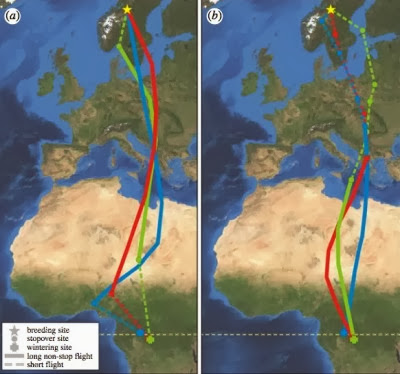Antonio Vulcano is a Research Intern with Birdlife Malta. His main commitments are with Life+Malta Seabird Project, carrying out boat based observation at sea and fieldwork along the coastline in order to assertion which marine areas are the most important for Malta’s seabirds.
As an Intern with Birdlife Malta, I’ve been involved previously with Spring Watch and had occasion to witness the dreadfully hazardous migration that birds experience while passing over Malta. Autumn migration appears to be spread over a longer period of time compared to spring migration. Winter visitors are not in such a rush: the urgency of the breeding season is not there. This represents an additional threat for all the birds’ species especially birds of prey, since the time they spend on Malta is significantly elongated.
 |
| Migration routes of three Great Snipe. At left is their fall migration through Malta; at right, spring migration which is interrupted by a stopover in central Europe. Photo: http://people.eku.edu/ritchisong/migration.htm |
Birds of prey set off their migration through Europe in a broad front which narrows in to one or more preferred routes; termed ‘flyways’. A flyway acts like a bottle-neck, funneling birds into a narrow strip. Since Malta lies on one of these flyways, the sky can get quite crowded with these magnificent and graceful birds. Malta hosts several migratory species both during spring and autumn, which every year fly thousands of kilometers from their European breeding sites to their African wintering grounds. Raptors such as Marsh Harriers and Honey Buzzards are common visitors in the Maltese archipelago.
Today [28th September] during my morning shift, we have seen several raptors soaring and gliding over Buskett. We spotted some of them quite close by as they took flight from their roosts. They probably had been scared by the numerous shots. So far no accidents happened and we enjoyed the sight of these willowy predators. I heard other teams, during the past days, were less lucky and reported a shot honey buzzard and a dead black stork. I sincerely hope these will be isolated cases, even thought I’ am conscious of the likelihood that other sad stories will emerge in the following days.
 |
| Discarded shotgun shells left in the countryside. Photo: Ole Friis |
I’m really pleased to see young and older volunteers from all over Europe coming to join the camp and help BirdLife Malta. It is always good to have such knowledgeable and enthusiastic persons involved in the fight against the hunting lobby and changing the critical Maltese situations.This can already be considered a great success.

